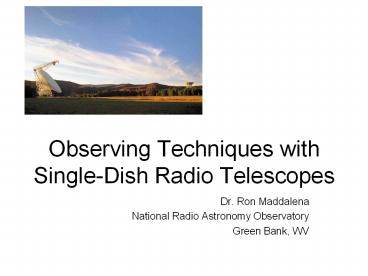Observing Techniques with SingleDish Radio Telescopes
Title:
Observing Techniques with SingleDish Radio Telescopes
Description:
Sampling 'Hysteresis' Reference observations. Use edge pixels _at_ no ... 'Hysteresis' From inaccurate time tags for either telescope positions or data samples ... –
Number of Views:58
Avg rating:3.0/5.0
Title: Observing Techniques with SingleDish Radio Telescopes
1
Observing Techniques with Single-Dish Radio
Telescopes
- Dr. Ron Maddalena
- National Radio Astronomy Observatory
- Green Bank, WV
2
Typical Receiver
3
Dual Feed Receiver
4
Model Receiver
5
Spectral-line observations
Raw Data
Reduced Data High Quality
Reduced Data Problematic
6
Reference observations
- Difference a signal observation with a reference
observation - Types of reference observations
- Frequency Switching
- In or Out-of-band
- Position Switching
- Beam Switching
- Move Subreflector
- Receiver beam-switch
- Dual-Beam Nodding
- Move telescope
- Move Subreflector
7
Frequency switching
- Eliminates bandpass shape from components after
the mixer - Leaves the derivative of the bandpass shape from
components before the mixer.
8
In-Band Frequency Switching
9
Out-Of-Band Frequency Switching
10
Position switching
- Move the telescope between a signal and reference
position - Overhead
- ½ time spent off source
- Difference the two spectra
- Assumes shape of gain/bandpass doesnt change
between the two observations. - For strong sources, must contend with dynamic
range and linearity restrictions.
11
Beam switching Internal switch
- Difference spectra eliminates any contributions
to the bandpass from after the switch - Residual will be the difference in bandpass
shapes from all hardware in front of the switch. - Low overhead but ½ time spent off source
12
The Atmosphere
- Opacity
- Tsys Trcvr Tspill Tcmb
exp(-TauAirMass) Tatm exp(-TauAirMass)
1 - Air Mass 1/sin(Elev) for Elev gt 15
- Stability
- Tsys varies quickly with time
- Worse when Tau is high
- Helps that the atmosphere is in the near field
13
Atmosphere is in the near field
- Common to all feeds in a multi-feed receiver
14
Atmosphere is in the near field
- Common to data taken in both positions of the
subreflector
15
Beam Switching Subreflector or tertiary mirror
- Optical aberrations
- Difference in spillover/ground pickup
- Removes any fast gain/bandpass changes
- Low overhead. ½ time spent off source
16
Nodding with dual-beam receivers - Subreflector
or tertiary mirror
- Optical aberrations
- Difference in spillover/ground pickup
- Removes any fast gain/bandpass changes
- Low overhead. All the time is spent on source
17
Nodding with dual-beam receivers - Telescope
motion
- Optical aberrations
- Difference in spillover/ground pickup
- Removes any fast gain/bandpass changes
- Overhead from moving the telescope. All the time
is spent on source
18
Mapping with a single pixel
- Map has a center
- Width x Height
- Spacing
- Nyquist sampling ? / 2D radians or less
- Typically 0.9 ? / 2D radians
- Loosely related to FWHM beamwidth (1.2 ? / D
radians)
19
Projection effects
20
Types of maps
- Point map
- Sit, Move, Sit, Move, etc.
- On-The-Fly Mapping
- Mangum, Emerson, Greisen 2008, Astro Astroph.
- Slew a column or row while collecting data
- Move to next column row
- Basket weave
- Should oversanple 3x Nyquist along direction of
slew
21
Other mapping issues
- Non-Rectangular regions
- Sampling Hysteresis
- Reference observations
- Use edge pixels _at_ no costs
- Interrupt the map
- Built-in (frequency/beam switching, nodding,
etc.) - Basketweaving
22
Hysteresis
- From inaccurate time tags for either telescope
positions or data samples
23
Other mapping issues
- Non-Rectangular regions
- Sampling Hysteresis
- Reference observations
- Use edge pixels _at_ no costs
- Interrupt the map
- Built-in (frequency/beam switching, nodding,
etc.) - Basketweaving
24
Basketweaving
- S (?,f) ISource(?,f) IAtmosphere (?,f) ?
Pant(?,f) - ISource is correlated between the 2 maps
- IAtmosphere is not correlated
25
Mapping with multi-pixel receivers
- Useful when object larger than beam separation
- Uniform sampling difficult
- Redundant sampling
- S (?,f) ISource(?,f) IRcvr (?,f) ?
Pant(?,f) - ISource is correlated between the 2 maps
- IRcvr is not correlated
- Field rotation
26
Field Rotation
27
Astronomical Calibration
- Determine Tcal from calibrator
- A (V2-V1) (V4-V3)
- B (V4-V2) (V3V1)
- Tcal (A/B) (? Ap Ssrc /2k) exp(-TauAirMass)
28
Astronomical Calibration
- Determine strength of unknown source
- A (V8-V5) (V7-V6)
- B (V7-V8) (V6V5)
- TA (B/A) Tcal
- S 2kTA/? Ap exp(-TauAirMass)
29
Calibration in Actual Practice
30
Power Balancing/Leveling and Non-Linearity
- If linear, then (V2-V1) (V4-V3) should equal
zero, to within the noise
31
Sensitivity
- Radiometer equation s Tsys / Sqrt(BW t)
- But, were always differencing observations.\
- Hardware realities
- s K1 Tsys / Sqrt(K2 BW teffective Npol
Navrg) - K1 Reflects backend sensitivity (e.g., 1.23 for
a 3-level correlator) - K2 Independence of samples (e.g 1.2 for
correlator) - teffective tsig tref / (tsig tref)
- Npol 1 or 2 (hardware dependent, assume
unpolarized source) - Navrg Number of independent data streams
averaged together. - Position switching 1
- In-Band frequency switching 2
- Etc.
32
Stray radiation































